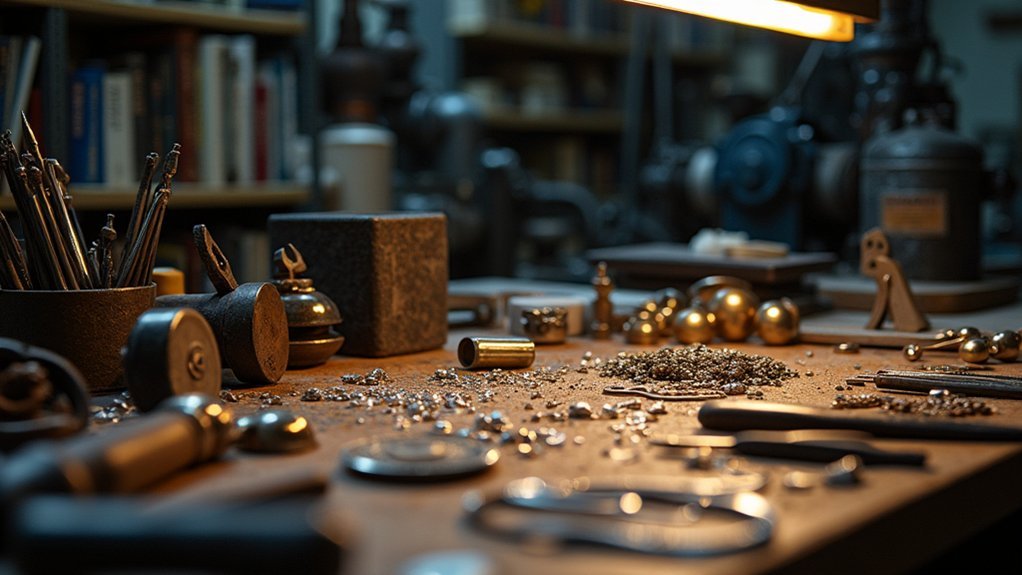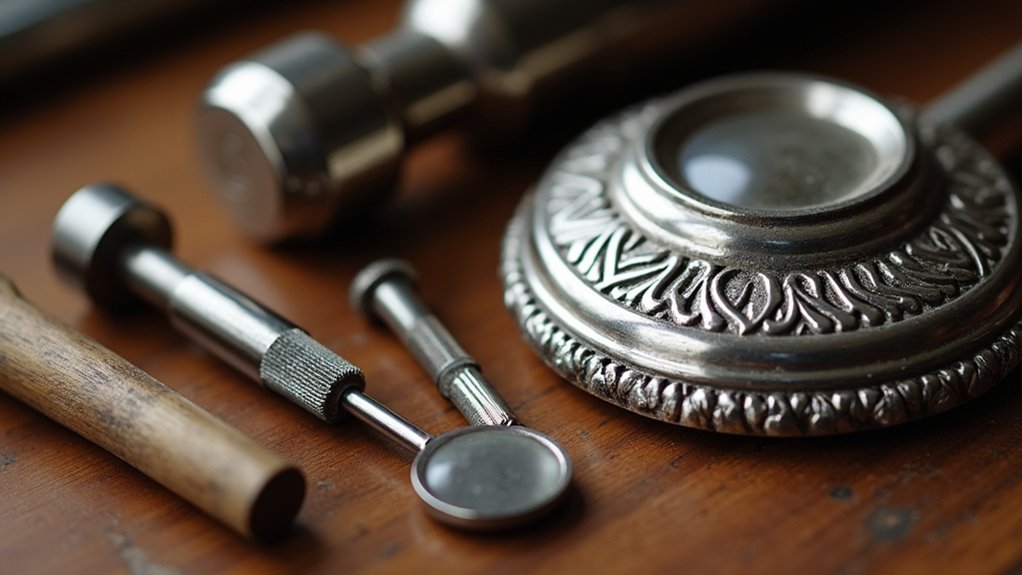To become a certified jewelry craftsman, you’ll need a high school diploma and specialized training through vocational programs covering metalworking, stone setting, and design principles. Gain hands-on experience through apprenticeships and workshops while developing a strong portfolio showcasing your technical skills and artistic vision. The certification exam requires 2-5 years of relevant experience and consists of 50 multiple-choice questions completed online. Explore how these steps open up advanced career opportunities and industry recognition.
Essential Educational Requirements for Jewelry Craftsman Certification

While you don’t need a college degree to become a certified jewelry craftsman, you’ll need at least a high school diploma or GED to start your journey in this specialized field. This basic educational foundation opens doors to entry-level positions where you can begin learning the trade.
Vocational schools offer targeted jewelry-making programs that teach essential foundational skills required for certification. These courses cover metal working, stone setting, and basic design principles. However, classroom learning alone isn’t sufficient.
You’ll need practical experience through hands-on training and apprenticeships with experienced jewelers. Many aspiring craftsmen also attend specialized jewelry schools for advanced techniques.
Throughout your education, you’ll build a portfolio showcasing your completed projects and designs, which becomes vital evidence of your skills when seeking certification.
Specialized Training Programs and Course Options
Beyond basic educational requirements, specialized training programs offer targeted pathways to develop the advanced skills you’ll need for certification.
Vocational schools provide focused programs in jewelry making that emphasize hands-on experience with professional tools and materials. You’ll learn techniques for creating various handmade jewelry pieces while building practical expertise.
Vocational programs deliver intensive, hands-on jewelry making training with professional-grade tools to build real-world crafting expertise.
Advanced courses expand your capabilities through Computer-Aided Design (CAD) software training, enabling you to create detailed digital designs and prototypes.
Certification programs like those from Jewelers of America validate your skills and enhance professional recognition within the industry.
Continuous education through workshops and seminars keeps you competitive in the evolving market.
These opportunities cover gemology, industry trends, and emerging techniques, ensuring your skills remain current and marketable throughout your jewelry crafting career.
Hands-On Experience Through Apprenticeships and Workshops

Although formal education provides essential foundational knowledge, you’ll develop your most valuable skills through direct, hands-on experience in real jewelry-making environments.
Apprenticeships offer invaluable practical experience under experienced jewelers’ guidance, allowing you to refine techniques in authentic workshop settings. Many jewelry-making programs incorporate specialized workshops where you’ll practice stone setting, metalworking, and engraving to enhance your craftsmanship.
These collaborative environments enable you to learn from peers while building a diverse portfolio showcasing your abilities.
Gaining experience through internships or apprenticeships considerably increases your job prospects, as employers prefer candidates with practical knowledge and training.
The combination of hands-on experience from apprenticeships and workshops is essential for developing the technical skills needed to achieve certification as a jewelry craftsman.
Building Technical Skills in Metalworking and Stone Setting
You’ll need to master essential metalworking techniques like soldering, casting, and forging to create durable jewelry pieces that stand the test of time.
Stone setting methods such as prong, bezel, and pave settings require precision and a steady hand to securely incorporate gems into your designs.
As you progress, you’ll develop advanced craftsmanship skills through continuous practice with specialized tools like pliers, hammers, and soldering irons.
Essential Metalworking Techniques
Developing proficiency in essential metalworking techniques forms the backbone of any successful jewelry craftsman’s skill set. You’ll need to understand metal properties like malleability and melting points to effectively shape and join materials.
Master tools such as soldering irons, hammers, and anvils for manipulating metal into desired forms.
Practice fundamental techniques including filing, polishing, and annealing to achieve smooth finishes that enhance your jewelry’s durability and appearance.
Stone setting requires precision through methods like prong, bezel, and channel settings, each offering different aesthetic outcomes and security levels for gemstones.
Gain hands-on experience through apprenticeships or specialized courses to refine these metalworking techniques. This continuous practice is essential for achieving the skill level required for certification as a professional jewelry craftsman.
Stone Setting Methods
When selecting the right stone setting method, consider both the gemstone’s characteristics and your design vision, as each technique offers distinct advantages for security and visual appeal. You’ll need to master prong, bezel, channel, and pavé settings through certification programs that emphasize precision and craftsmanship. Understanding gemstones properties is essential since different stones require specific approaches to prevent damage.
| Setting Method | Security Level | Best For |
|---|---|---|
| Prong | High | Diamonds, hard stones |
| Bezel | Very High | Soft stones, daily wear |
| Pavé | Medium | Small accent stones |
Your metalworking skills will develop through hands-on practice with setting burins, gravers, and pliers. Advanced stone setting techniques in these programs focus on real-world applications, ensuring you can create durable, beautiful jewelry pieces.
Advanced Craftsmanship Skills
Mastering fundamental stone setting methods provides the foundation for advancing into sophisticated metalworking techniques that define professional jewelry craftsmanship.
You’ll develop advanced craftsmanship skills by mastering essential jewelry making techniques like soldering, casting, and precision stone setting. Understanding metal properties—including melting points and workability—enables you to manipulate materials effectively during metalworking processes.
You must perfect stone setting techniques such as prong, bezel, and pave settings to integrate gemstones securely and aesthetically. Hands-on experience with specialized tools like torches, hammers, and pliers develops your technical skills and precision.
Continuing education through workshops and certifications enhances your abilities considerably. Organizations like Jewelers of America offer valuable programs that keep you updated with industry standards and innovations, ensuring your craftsmanship meets professional requirements.
Portfolio Development and Design Documentation
As you progress toward certification, your portfolio serves as the most powerful proof of your skills and artistic vision in jewelry crafting. Effective portfolio development requires showcasing diverse pieces that demonstrate your jewelry design capabilities and technical expertise.
Document each creation with detailed photographs highlighting intricate details, finishes, and quality of materials used. Include close-ups that emphasize your craftsmanship and the specific techniques used in each piece.
Capture every detail through professional photography that showcases your technical mastery and the superior quality of your jewelry craftsmanship.
Write thorough descriptions explaining your design inspiration, materials used, and unique methods applied. This documentation demonstrates your technical knowledge and creative process.
Regularly update your portfolio with new work to reflect your evolving style and growing expertise. Consider creating a digital platform or website to reach broader audiences, making your work easily accessible to potential clients and employers while maintaining professional organization.
Certification Examination Process and Requirements

Building a strong portfolio prepares you for the next major milestone in your certification journey: passing the formal examination administered by the AIPC.
This certification examination is conducted online, lasting 1.5 hours with 50 multiple choice questions covering core certification modules.
You’ll need a bachelor’s degree from a recognized institution plus 2-5 years of relevant work experience in jewelry crafting to qualify.
However, if you lack formal education but possess exceptional professional experience, you can apply for approval through the AIBM evaluation committee.
Interestingly, professionals with significant industry expertise may receive examination exemptions based on their qualifications.
Since exam structures can change, you should verify current requirements before your test date to ascertain you’re properly prepared.
Professional Development and Advanced Specializations
Once you’ve earned your initial certification, expanding your expertise through advanced specializations becomes essential for distinguishing yourself in the competitive jewelry industry.
Professional development opportunities through institutions like Jewelers of America offer specialized courses that enhance your technical skills in jewelry design and production. You’ll want to pursue continuous learning in gemology, antique jewelry, and cutting-edge manufacturing techniques to stay current with industry trends.
Advanced specializations considerably boost your marketability and credibility. Consider pursuing additional certifications beyond the basic Bench Professional levels. Master-level credentials validate your expertise and open doors to premium opportunities.
Don’t overlook networking at industry events and gem shows. These connections provide valuable insights into market demands while expanding your professional circle, ultimately accelerating your career growth in this specialized field.
Career Advancement Opportunities for Certified Craftsmen

Certified jewelry craftsmen enjoy substantial career advancement opportunities that extend far beyond entry-level positions. Your certification validates skills to national standards, enabling you to command higher salaries and access specialized roles like master bench jeweler or advanced sales positions.
The jewelry industry values certified professionals for their proven expertise and commitment to quality standards, providing enhanced job security.
Certification opens doors to professional jewelry businesses and management positions. You’ll gain valuable networking opportunities through organizations like Jewelers of America, connecting you with industry professionals and educational resources.
These connections accelerate career advancement by exposing you to new opportunities and industry trends. Additionally, your certification serves as a foundation for entrepreneurship, allowing you to establish your own jewelry brand with credible expertise backing your venture.
Frequently Asked Questions
How Long Does It Take to Become a Certified Jeweler?
You’ll typically need 2 to 5 years to become a certified jeweler, depending on your prior experience and chosen certification track. You can complete jewelry-making programs in 1-2 years before pursuing certification.
How to Get a Certificate of Authenticity for Jewelry?
You’ll need to document your jewelry’s specifications and obtain supporting evidence like receipts, appraisals, or gemological lab reports. Many retailers automatically provide COAs with high-value pieces during purchase.
How Do I Become a Jewelry Fixer?
You’ll need a high school diploma, then complete jewelry-making training. Gain hands-on experience through apprenticeships, pursue Bench Professional Certification, network at industry events, and continuously update your skills through workshops.
What Qualifications Do You Need to Be a Jewellery Maker?
You’ll need a high school diploma or GED, then complete jewelry-making programs or apprenticeships. Obtain certifications from organizations like Jewelers of America and build a strong portfolio showcasing your designs.
In Summary
You’ve now got the roadmap to becoming a certified jewelry craftsman. Don’t skip the educational foundation or hands-on training—they’re essential for mastering metalworking and stone setting techniques. You’ll need to build a strong portfolio and pass certification exams, but the investment’s worth it. Once you’re certified, you can pursue advanced specializations and access better career opportunities. Start with basic courses, find apprenticeship programs, and commit to developing your craft consistently.





Leave a Reply